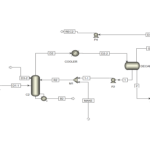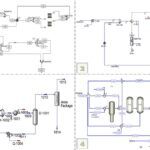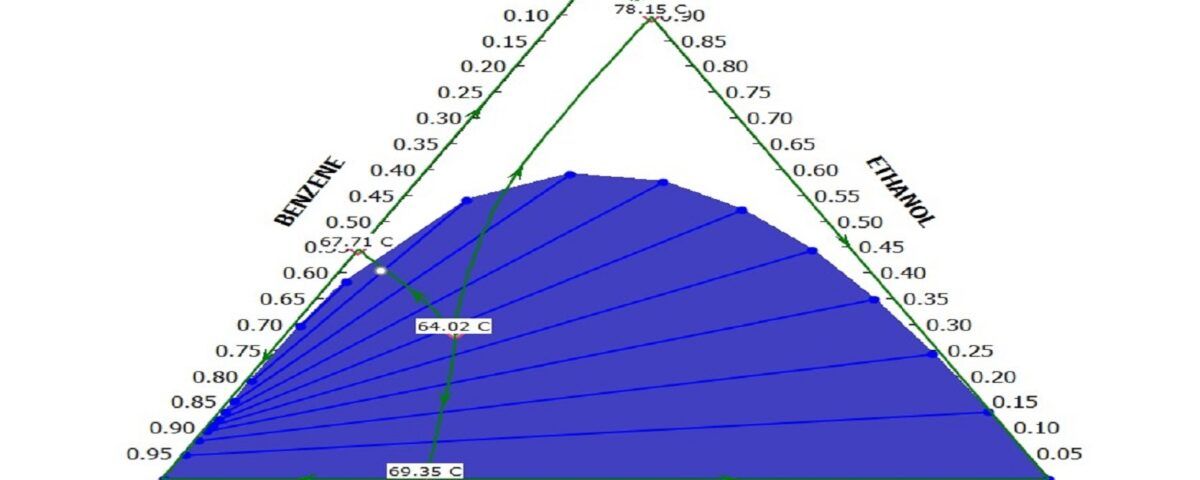Introduction
The objective of this project was to enhance the simulation of heterogeneous ethanol dehydration, which was initially conducted using Aspen Plus software. In the preliminary simulation, the separation process of ethanol, benzene, and water was modeled using experimental data. However, further analysis revealed a need to improve the alignment between the simulation results and experimental data. Consequently, this project employed data regression and distillation simulation to increase simulation accuracy and achieve more optimized results.
Data Regression Process Initial Data Analysis
In the initial simulation, experimental data was used to assess the performance of the separation process. The triangular diagram below illustrates the status of this data before regression was applied. As shown in the figure, there were discrepancies between the experimental and simulation data, necessitating improvement.
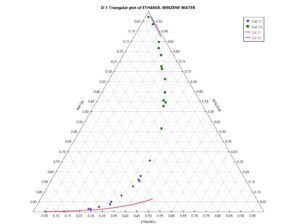
Application of Data Regression
Data regression was employed to enhance simulation accuracy and minimize discrepancies between experimental and simulated data. This process involved adjusting and optimizing the parameters of the thermodynamic models.
Post-Regression Results
The results obtained after applying data regression exhibited a significant improvement. As illustrated in Figure [Figure Number], the alignment between the simulated and experimental data has notably improved, with a reduction in discrepancies.
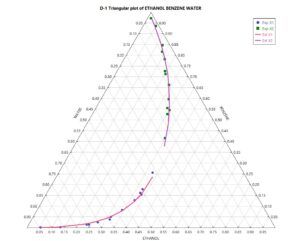
Introduction to Distillation Simulation
Distillation simulation is a crucial process in the chemical industry, employed to separate multicomponent mixtures into their pure components or higher purity fractions. In this project, after refining thermodynamic models through data regression, distillation simulations were conducted using Aspen Plus software. The objective of these simulations was to investigate the performance of distillation columns, including the distribution of temperatures and various compositions throughout the distillation stages. A distillation column is divided into multiple sections, where different components separate at different temperatures. Due to the thermodynamic complexities and strong dependence on operational conditions, this process requires accurate modeling and optimization. The thermodynamic models, enhanced through data regression, enabled the simulations to more accurately predict real-world conditions. This improvement in model accuracy led to more reliable results in forecasting process performance.
Distillation Simulation Results
Upon executing the distillation simulations, the results demonstrated a significant impact of model improvements on prediction accuracy. Key information obtained from the distillation simulations includes:
- Temperatures at each stage: These temperatures indicate the energy required to separate components at each point in the distillation column.
- Component compositions at each stage: This section reveals which components and their respective purities are separated at each stage.
Process optimization: This information is utilized to determine optimal operational conditions. Such optimization leads to reduced energy consumption, increased product purity, and overall process efficiency. A distillation synthesis diagram visualizes the results of the distillation simulation
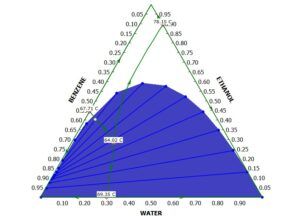
“This diagram” illustrates the temperature distribution along the distillation column. As we move upwards in the column, the temperature decreases, indicating an increase in the purity of lighter components (such as ethanol). It also displays the various compositions, revealing the quantity of each component at different points in the column and how these compositions change throughout the separation process.
Conclusion
The results of this project demonstrate that employing data regression and distillation simulation can significantly enhance the accuracy of thermodynamic simulations. These refinements have led to a closer alignment between experimental data and simulated results, resulting in more precise predictions of separation process behavior. These improvements can contribute to future optimizations of industrial processes and the production of higher-quality products.
Related Projects
SANILCO Company has successfully implemented numerous projects in the field of heterogeneous ethanol dehydration, including:
-
Heterogeneous Ethanol Dehydration Simulation using Aspen Plus
In this project, the heterogeneous ethanol dehydration process was simulated using Aspen Plus versions 10 and 12, based on the methods and data from a published article. The project focused on analyzing and optimizing operational parameters. -
Ethanol Dehydration Simulation using the UNIQUAC Model in Aspen Plus
Following the analysis of ethanol dehydration using the NRTL model, this project investigated the process using the UNIQUAC thermodynamic model. This model, considering non-ideal interactions between mixture components, exhibits higher accuracy in predicting phase behavior and mixture separation, especially in more complex conditions. -
Simulation and Optimization of Ethanol Separation from Water in Aspen Plus
In this research, heterogeneous ethanol dehydration was simulated and optimized using Aspen Plus with the aim of generalizing the results to an industrial unit. The primary objective was to reduce operational costs and increase energy efficiency while considering real-world industrial conditions. -
Dynamic Simulation of Heterogeneous Ethanol Dehydration Process using Aspen Plus
This project detailed the dynamic simulation of heterogeneous ethanol dehydration using Aspen Plus Dynamics. The report aims to analyze the dynamic behavior of the process and optimize operational conditions and control systems.
Improving Heterogeneous Ethanol Dehydration Simulation through Data Regression in Aspen Plus
In this project, the heterogeneous ethanol dehydration simulation was improved using data regression in Aspen Plus. The project focused on analyzing and optimizing operational parameters.
